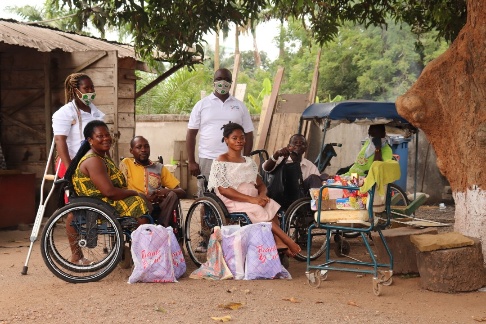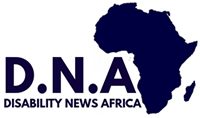
The life dreams of Mr Angnayage Kabiebata, a 26-year-old man with disability, of tasting formal education have been cut short due to the challenges he went through in accessing basic education.
The young man dropped out of school at Primary three after his mobility aid dropped out of school, perhaps due to the distance and the ordeal of pushing Mr Kabiebata to and fro school every day.
The challenge
Mr Kabiebata lived in the Kaangu community in the Nadowli-Kaleo District, but attended a primary school located at Piree, about 10km from Kaangu.
He was pushed in a wheelchair to and fro school every day by a brother.
Perhaps, if a primary school was located at Kaangu, Mr Kabiebata would have been able to complete, at least, primary six before cutting short his education career.
It was however baffling to think through that, even if Mr Kabiebata’s aid had endured the ordeal and pushed him to and fro daily until he completed primary six at Piree, how would Mr Kabiebata had attended Junior High School at Sombo, a community that was about 18km from Kaangu?
The situation was not peculiar to Mr Kabiebata, many other children with disabilities, and perhaps those without any form of disability, in rural communities had been deprived of their right to formal education due to their inability to access schools.
However, Professor Elijah Bisung of the Queen’s University, Canada, once observed that depriving children with physical disabilities of their right to education also denied them of the opportunity to develop their full potential which the country, Ghana could harness to achieve the needed development.
Prof. Bisung made that observation at a research dissemination workshop on “Promoting Access to Inclusive Water, Sanitation and Hygiene (WASH) services for Students with Physical Disabilities in School Setting in Ghana”, about a year ago.
Causes
Many factors accounted for the inability of some children with disability to access basic education.
They included but were not limited to a lack of disability-friendly school infrastructure, distance, and financial challenges.
For instance, the non-availability of inclusive Water Sanitation and hygiene (WASH) facilities in basic schools discouraged some children with physical disabilities from enrolling in schools.
Also, for children with mobility challenges, many school buildings in the country, and the Upper West Region to be specific, were not friendly to them.
As such children on wheelchairs could not easily access them without the support of others.
That was contrary to the Persons with Disability Act, 2006 (Act 715) which sought to, among other things, ensure public facilities including schools were disability friendly.
Distance
Aside the unfriendliness of some basic schools to children with physical disabilities which deprived them of their right to education, the distance of some schools from communities also denied many children with physical disabilities, especially those with mobility challenges from accessing basic education and training.
In some rural communities, children had to trek several kilometres to other communities to either access primary or junior high education.
A recent report by the Ghana News Agency (GNA) (https://gna.org.gh/2023/07/children-trek-18km-daily-in-search-of-high-school-education/) revealed that children at Kaangu and Piree communities in the Nadowli-Kaleo District had to trek about 18km and 8km respectively to Sombo daily to access Junior High Education.
Meanwhile, the children at the Kaangu community had to also trek 10km daily to and fro Piree for primary education.
That meant children with mobility challenges at Kaangu could not access either primary or Junior High Education while those at the Piree community were deprived of Junior High Education.
The GNA report indicated the children who could not endure the ordeal of trekking that distance gave up on education and resorted to other activities, mostly farming or travelling to southern Ghana to engage in activities such as illegal mining.
How much more to talk of children with mobility challenges in those communities, how could they access education which was a right to enjoy?
“The issue of a JHS is a big worry to us. There is no JHS here apart from Sombo. After primary school, the children at Kaangu and Piree have to go to Sombo for the JHS but the distance from Piree to Sombo is about 4km and from Kaangu to Piree is also about 5km”, Mr Camillus Tatuara, the Assembly Member of the Sombo East Electoral Area, said.
That was not peculiar to the Piree and Kaangu communities, children with Physical disabilities, especially those with mobility challenges in many other communities in the Upper West Region in particular were denied their unalienable right to education owing to their inability to commute to distant communities to access basic education.
The law
Section 10 (2) of the Children’s Act of 1998 (Act 560) states that: “A disabled child has a right to special care, education, and training wherever possible to develop his maximum potential and be self-reliant.”
Also, target 4.5 of the United Nations (UN) Sustainable Development Goals (SDGs) enjoined member states that were signatories to the Goals to eliminate all forms of disparities in education by 2030.
It states that: “By 2030, eliminate gender disparities in education and ensure equal access to all levels of education and vocational training for the vulnerable, including persons with disabilities, indigenous peoples and children in vulnerable situations.”
Despite these and many other statutory provisions that sought to ensure equality, or better still equity in access to education by all Ghanaian children, access to basic education by some children with disabilities remained a privilege.
The PWD Act
Recognising the special needs of children with disabilities, the government of Ghana, with respect to international treaties and agreements, passed the Persons with Disability Act, 2006 (Act 715) to meet the needs of PWDs.
Section 7 of that Act provides that: “A person who provides service to the public shall put in place the necessary facilities that make the service available and accessible to a person with disability.”
Also, section 17 of the Act enjoins the Minister of Education to take steps to “designate schools or institutions in each region which shall provide the necessary facilities and equipment that will enable persons with disability to fully benefit from the school or institution.”
Further, the Act, in section 18, guarantees free education and special schools for persons with disabilities who by reason of their disability could not be enrolled in formal schools.
Special Schools
Special schools in the country were to serve children with visual, cognitive, and hearing impairments.
Children with mobility challenges were expected to access basic education from mainstream facilities without putting in place the necessary structures to ensure inclusiveness.
Even with the special schools, the government was indifferent to adequately resource those institutions to enable them provide quality training for the children. Feeding for special schools in Ghana was a challenge.
Government interventions
It is noteworthy that the government of Ghana and its development partners had put in place diverse interventions to meet the educational needs of persons with disabilities.
They include the establishment of special schools across the country with three of such schools located in the Upper West Region, precisely, Wa.
Also, many educational facilities were being constructed in some communities to bring access to basic education to the doorsteps of the Ghanaian children, including children with physical disabilities.
However, these interventions were not enough to ensure that distance did not drive any child of his or her right to education.
Recommendations
With barely six years to account for the successes and achievements or otherwise, the failures of governments in attaining the SDG target, the government of Ghana and its development partners ought to take steps to improve access to basic education by PWDs.
That could be realised if the government improved access to basic education in rural communities including the Kaangu and Piree communities.
Also, where existent, the school facilities should be designed to be disability-friendly, especially for children with mobility challenges to enable them have access to the facilities.
It was also prudent that the government should design and implement appropriate policies geared towards addressing the inherent inequalities in access to education, particularly by children and for that matter PWDs in rural communities.
Appropriate governmental institutions should also exhibit interest in the implementation of the Persons with Disability Act, 2006 (Act 715), which was virtually the only policy document on PWDs in Ghana, to reduce the inequalities in access to basic education.
By Philip Tengzu
Source: GNA






